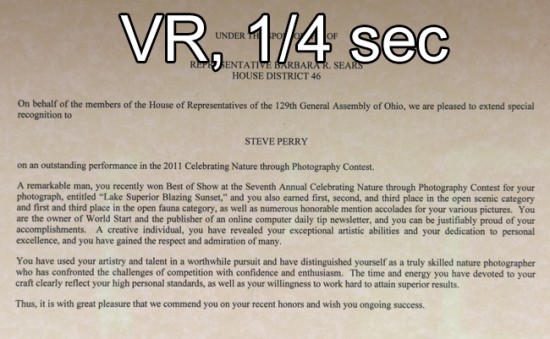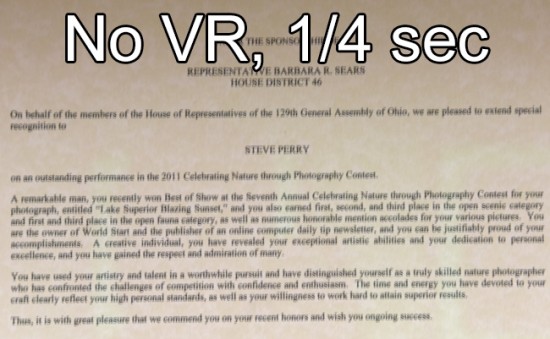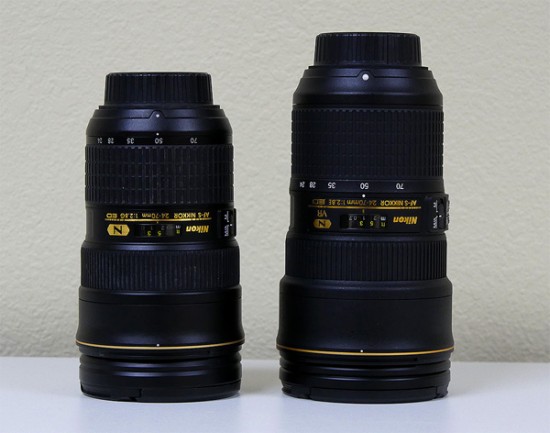
This Nikon AF-S Nikkor 24-70mm f/2.8E ED VR lens review is by Steve Perry (website | YouTube | Facebook):
I remember it like it was yesterday. Just a few months back, Nikon announced a new version of their 24-70mm lens (the AF-S 24-70mm E VR). I use the old version of this lens all the time and I have to admit, reading the announcement got me more excited than a college girl getting a free pumpkin spice latte.
So, I ordered one right away, images of grand landscapes dancing through my head – all with perfect corner to corner sharpness of course.
When this lens arrived, I raced out to test it – I was brimming with questions that begged for answers – particularly how it stacked up against the “old” 24-70mm. Little did I know what kind of surprises I was in for – this wasn’t exactly what I thought it was going to be. Luckily, I have no affiliation with Nikon, so I can speak my mind and freely reveal the good, the bad, and the ugly about this new lens.
Also, keep in mind I’m not a professional lens reviewer, and I was only able to test one copy of the new lens against my one copy of the old lens. Ideally, I would like to test a bushel basket of each lens to average out sample variation, but for this review we’ll have to settle for the glass I have at my disposal.
The first thing you’ll notice about this new 24-70 is that it seems to have been hitting the french fries a little too hard. It’s gained a bit of weight from the slimmer 2007 version (I know how it feels), as well as gathering a bit more girth and height. While you won’t need to press your spouse into service as a sherpa, you will need a bit more space in your bag to haul it around. So, if you were dreaming about a smaller, lighter optic, then you’re going to be disappointed. Also, the filter size gets bumped from 77mm to 82mm, so break out the wallet for a new set of filters.
As for the build quality itself, it feels at least as robust as the old 24-70mm. The zoom and AF rings are silky smooth and it seems almost eager to take on whatever challenges you want to throw at it. Of course, all of this is speculation on my part, only time will tell if it’s tougher than the current model – which was known to wear out with excessive use. I’m on my second copy of the first version of this lens and the zoom ring has recently been making like it’s got peanut butter stuck in there. Sigh.
This new lens also features VR and – for my shaky hands – it seems to grant another 3-4 stops of hand-hold ability. The VR seems to work exceptionally well, and I’ve been very impressed with it. As to whether or not you need it, that’s going to vary from person to person, however, I imagine if you shoot in a lot of dark venues it could come in handy.
What about AF?
There has been a significant improvement in AF speed. It’s not like the old lens was sluggish, but this locks on like a teenage boy peeping into the girls locker room. Even Live View AF was much quicker than the old lens. As an added bonus, my copy needed ZERO AF fine tuning – spot on right out of the box.
This is also an “E” series lens – not to be confused with the original E series Nikkors that graced the shag camera bags in the late 70s and early 80s. The current “E” stands for “Electronic,” referring to an electronically controlled aperture rather than a mechanically controlled one.
I’ve seen Nikon offering a lot of new “E” type glass recently, and I suspect it’s for compatibility with the upcoming D5 camera. I’m speculating that the new camera will probably run 15 frames per second and I’m guessing that the old mechanical aperture can’t keep up, hence the rash of new lenses we’ve seen lately.
OK, so how about sharpness?
Well, I shot several hundred photos at various F/Stops at various locations and I was anxious to watch this lens optically annihilate the original one – at least that’s what I expected would happen. All tests were shot with a D810 on a tripod, focused via live view, mirror locked up, using electronic front curtain, and with a cable release.
In the center areas using mid range F/Stops, sharpness is close at pretty much all focal lengths. Looking from image to image, I just don’t see a significant difference between the center area of the new lens and the old. Sure, in some cases the new lens might be just a touch better, especially at the wide end – and in other cases it actually seems like the old lens has a slight edge. I’ve also noticed that this can flip flop a bit depending on subject distance, but overall, it seems to be a practical wash at mid-range apertures across the focal range in the center of the image.
Here are a few test shots at F/8, be sure to click them to enlarge (also, if you see a magnifying glass over the image when you open it, click it one more time for full resolution
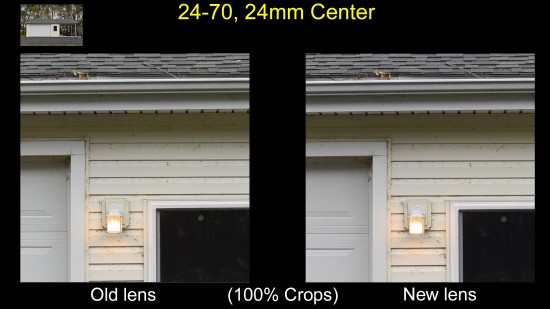
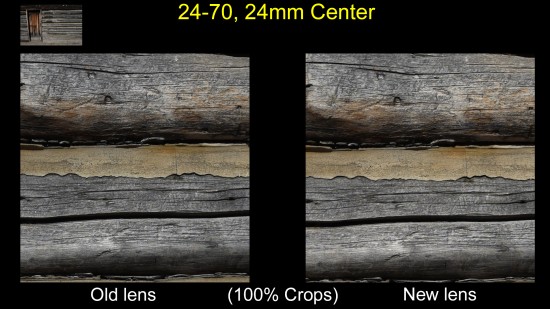
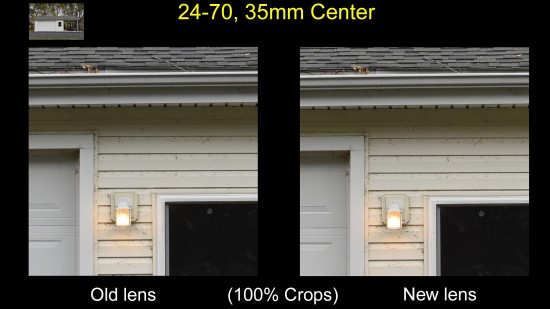
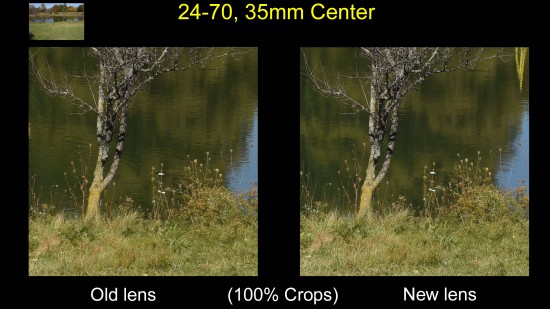
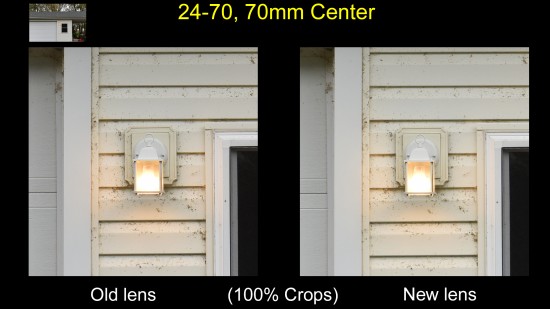
When I open the lens to F2.8, it seems like, at least from 35mm and up, the old lens actually has an advantage over the new one in the center. Nope, I didn’t get struck with a brief episode of dyslexia just now, you read that right. It’s not huge, but it seems like the old lens consistently keeps AHEAD of the new one wide open. My mind was so blown by this I must have tried a dozen different scenarios, all with the same results.
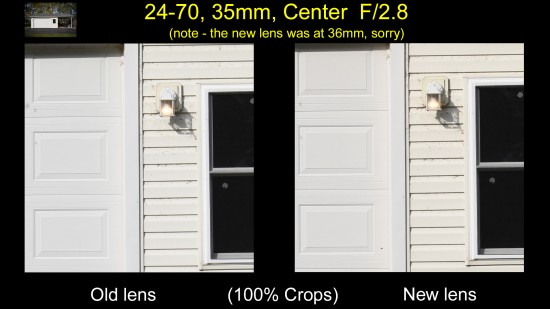
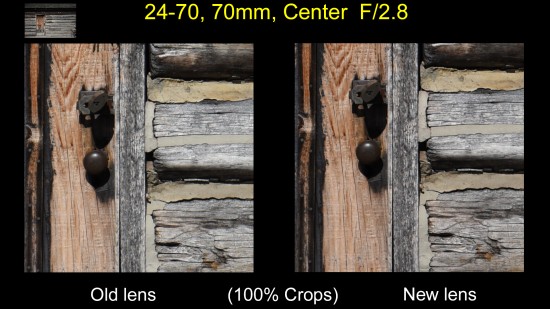
Now, as we start moving from the center areas to the mid sections, edges, and corners, the new Nikon turns things around. It is generally better at all focal lengths than the old lens, especially at the wide end. Where the old lens really struggles at 24mm ~ 28mm, the new lens manages to keep the corners much sharper. Additionally, there seems to be better overall mid-frame sharpness than the old lens, at least in general.
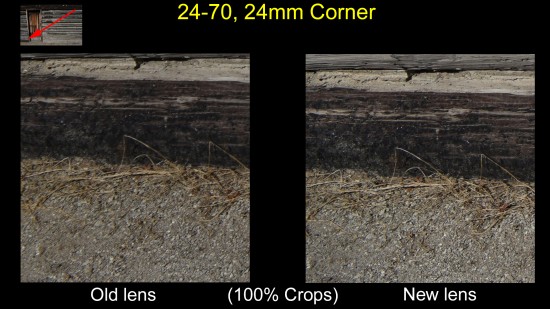
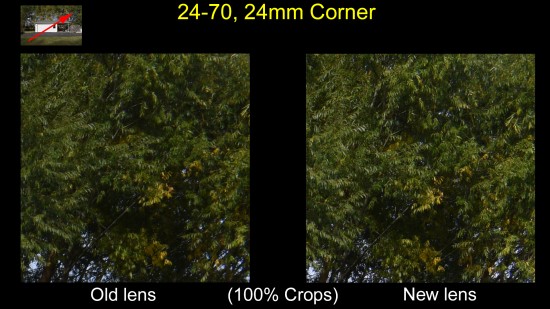
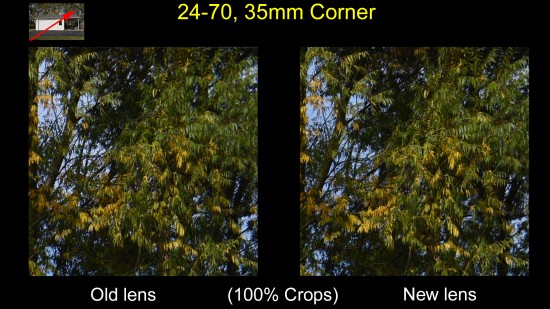
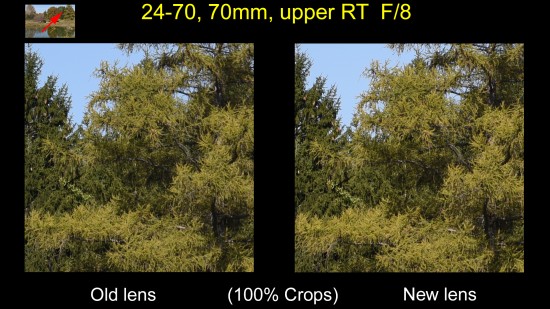
So, the bottom line is that if you were anticipating a GIGANTIC leap in sharpness, sorry, it just isn’t there. I’d rather say that the sharpness seems more evenly distributed across the frame, in some cases scraping off a little center sharpness for better edges and corners. Now, whether that’s a good thing or a bad thing depends on what you shoot. As a landscape guy, I’m thinking it’s an improvement. I like my entire frame to be sharp with no really weak areas, so I think I’m OK with losing a touch of center sharpness to have an image that’s sharper overall. Although, for the record, I wish it could have been pulled off while maintaining the same (or better) dead center sharpness.
Additionally, I also noticed the new lens has quite a bit more wide angle barrel distortion than the old one. As a landscape photographer this isn’t a huge problem for me, but I can’t imagine too many architectural photographers are going to be very happy about it.
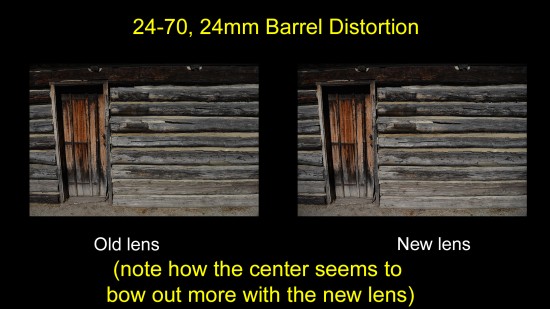
It also shows obvious vignetting wide open, particularly at the wide end, more than what we see with the current lens. Easily correctable, but it’s definitely there. It’s mostly gone by F4 and pretty darn good by F5.6.
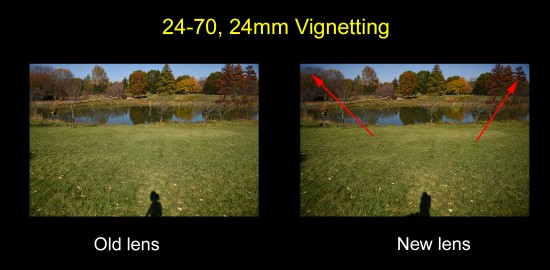
And that’s not the only bad news I discovered on the optical front. (You thought I was done, didn’t you?) This lens also seems susceptible to focus shift.
See, I was testing the new lens on closer subjects and I couldn’t help but notice it was really embarrassing itself in front of the old lens. I can understand a slight difference, but this was pitiable. I remembered seeing this mentioned in a few reviews and looking at the test shots, it clearly seems like the new lens doesn’t hold a candle to the old one at close range.
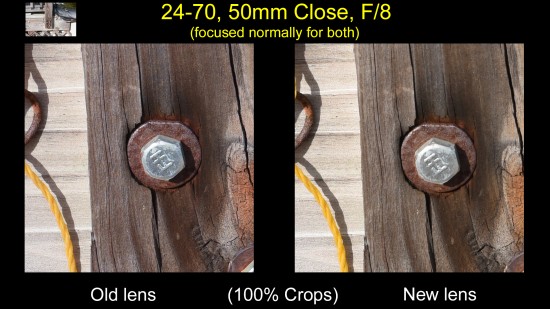
However, I started wondering if maybe there was a little focus shift going on. In case you’re not familiar with this concept, this is basically where the plane of focus changes slightly as you change F/Stops. If you focus at F/2.8 and drop down to say F/11, the plane of focus shifts slightly one way or the other. At normal distances, it’s usually not an issue and is more than covered by the added depth of field of the smaller selected aperture – but it can be a problem for closer subjects.
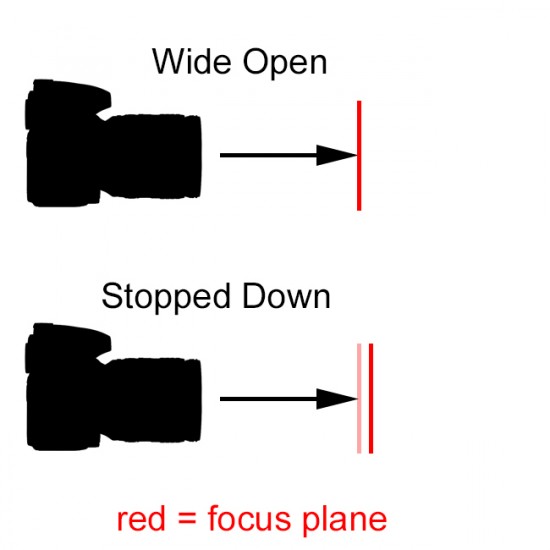
Now the REAL problem is that when you use phase detection AF – the kind you use when looking through your viewfinder. See, your lens always focuses wide open, regardless of the F/Stop. The lens only stops down to your selected F/Stop when you snap a photo, otherwise your viewfinder would get real dark when you start dropping to F/8, F/11, etc. So, if you focus via your viewfinder for close subjects with this lens, and select smaller F stops, you may have a problem.
However, this isn’t an issue with contrast detection AF, like the kind used in Live View.
With that in mind I did the test again, only this time while in Live View I made sure to refocus every time I changed the F/stop. Sure enough, the new lens turns out to be at least as sharp as the old one when using this technique – at least when both are at F8. However, it could still be a problem for regular AF shooters at close range, so it’s something to keep in mind. Also, note that the old lens does not seem subject to any focus shift, at least not any I could see or have experienced over the years.
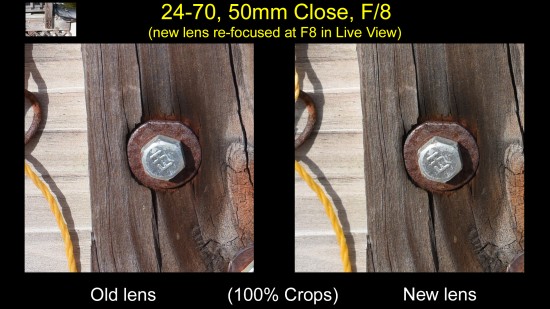
So, the new lens adds some nice features, but it also takes a step back when it comes to barrel distortion, focus shift, and it looks like it gives up some center sharpness, especially wide open.
As for if you should upgrade or not, that’s a tough call so I made a list for you to consider.
- If you shoot hand-held in low light situations, the VR alone may be worth the upgrade.
- If you need faster AF.
- If you need slightly better mid-frame sharpness and much better edge and corner sharpness.
- If you anticipate using this lens at high frame rates with a D5.
- If you think the current 24-70 has stopped working now that the new one is out.
On the other hand, the current 24-70 is no slouch and the two lenses are really close in sharpness in the middle part of the frame. So, if most of your subjects tend towards the center part of the lens, you don’t need VR, and the AF is fast enough in the old version, there’s probably no reason to upgrade.
For me personally, it looks like I’m going to keep this one. I have to admit, I’ve been going back and forth over the last few days, but I think – at least for my type of photography – that there are enough advantages to justify keeping it.
This review was originally posted here. You can check also Steve’s previous [NR] posts here.
If you have an interesting idea for a guest post, you can contact me here.
